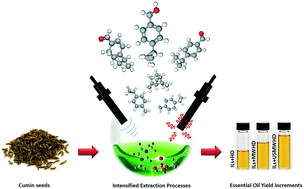Ionic liquids, ultra-sounds and microwaves: an effective combination for a sustainable extraction with higher yields. The cumin essential oil case†
Abstract
This paper deals with the concept of process intensification applied to the extraction of essential oil (EO). Microwave hydrodistillation (MWHD) and simultaneous ultrasound MW-assisted hydrodistillation (US-MWHD) were intensified by coupling them with a green tool: ionic liquids (ILs). The yield and chemical composition of the cumin EO obtained by MWHD and US-MWHD were compared with those from conventional hydrodistillation (HD) using water and three mixtures of water with three different ILs synthesized ad hoc, as maceration and extraction media, and analysed by a multivariate statistical analysis approach. The cumin EO was chemically characterized by GC and GC-MS analysis. The interaction of the ILs and ILs–H2O mixtures with MW was experimentally investigated and discussed, while the ILs dipole moments and optimized geometry in vacuo and in water were calculated at the DFT level. The different approaches were also compared in terms of energy and time savings. All the data clearly showed that the most promising approach was US-MWHD using a 1,3-dimethylimidazolium dimethylphosphate mixture as maceration and extraction medium. A total yield increase was achieved of up to 75% and an energy saving of 46% compared to the classical HD. The proposed technology, using ILs as green solvents, which fits well with the MW and US technology, enabled a continuous-flow and batch extractor to be constructed which would be useful for industrial applications.



 Please wait while we load your content...
Please wait while we load your content...